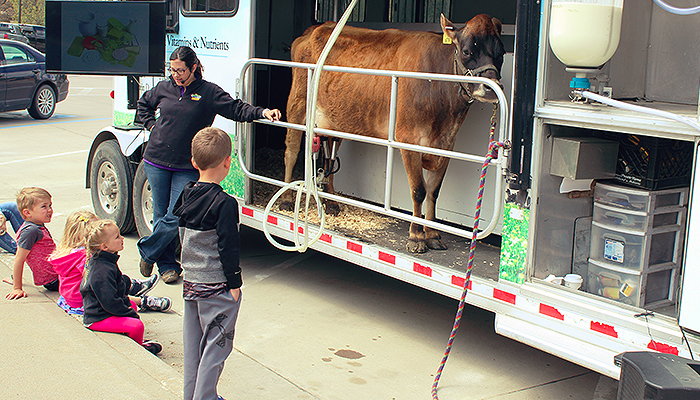
By CRISTINA JANNEY
Hays Post
The FHSU Ag Day on Thursday was not just an event for farmers, but had information about how everyone can relate to their environment and their food.
Alpha Gamma Rho, the FHSU ag fraternity, offered information about beef. The group offered pamphlets with beef recipes, a display identifying the cuts of beef and a poster listing an A-to-Z of beef products. It is not just steaks.
Casey Jensen, senior in ag business, said visitors seemed to be the most surprised that a beef product is used in making toilet paper.
Jensen, who is from Courtland, hopes to rejoin the family cattle ranching business after graduation.
A popular stop in the quad was the chicken table, which was hosting chicks.

Katie Pelton, a FHSU graduate in ag business, grew up raising chickens, ducks, pigs, cattle, horses and other livestock on her parents’ farm in Colorado.
“I love agriculture, and I love advocating for agriculture,” she said.
Pelton was handing out candy — popular with the students. She noted items such as York Peppermint Patties or Three Musketeers contain eggs. Eggs are contained in may foods and eggs by themselves are a good source of protein.
Elissa Jensen, who is majoring in conservation ecology and natural resources, represented the FHSU Bee Club Thursday and was advocating for pollinators. The club gave away salvia plants, a nectar producing flower. The club has two hives on campus, which produced more than 60 pounds of honey last year.
Although bees sometimes are elusive, Jensen said the trees around campus are likely loaded with the insects at this time of year.
“Humans are the major factor behind the destruction of the bee population, sadly,” Jensen said.

She encouraged people to plant bee-friendly flowers and if you spray your lawn or garden, try to do it in the early morning or evening when bees are less active. Also be mindful of the wind that can cause chemicals to drift.
Birds, bees and butterflies will also benefit from a water source, which can be as simply as a dog bowl set outside with a little bit of water in it.
Andrew Tucker, agronomy professor, was helping exhibit ag technology, including a drone and sensor equipment that helps farmers better use their resources.
A sensor attached to a drone can measure the photosynthetic capacity of crops. The drone is flown in a grid and creates a map with GPS coordinates. Areas that show up dark green are producing well, whereas light green, yellow or red areas are not producing as well. This allows farmers to adjust the amount of water or fertilizer they apply to certain portions of their crop.
“You use it where you need it. That way you are not concerned about getting nutrients in our groundwater supply that we don’t want there or have problems with runoff,” Tucker said. “It makes farmers more efficient and environmentally friendly.”
Companies flying surveys charge about $4 to $5 per acre, but a farmer can save an average of 25 pounds of nitrogen per acre. If the price of nitrogen is 40 cents per pound, that is a $10 savings per acre. That still amounts to a $5 to $6 per acre net savings for the producers.

Sigma Alpha, FHSU ag sorority, manned a display on farm safety. Common accidents on the farm are the result of grain bin entrapment and equipment rollovers.
“We are trying to talk about accidents and how to prevent them and overall safety on the farm,” said Jenna Berkgren of the sorority.
Between 2012 and 2017, 11 percent of all U.S. farms experienced an accident.

The Block and Bridle Club had a display illustrating cow and horse digestion. This included preserved specimens of the livestocks’ multi-chamber stomachs. The students used yeast, sugar water and hay on a hot plate to exhibit the process in ruminant system.
